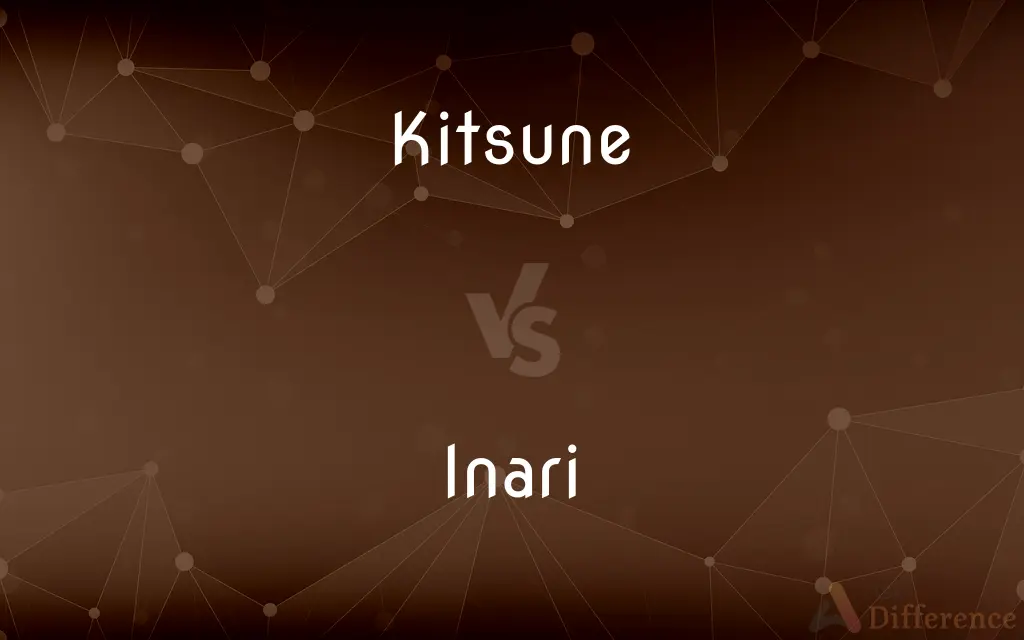Kitsune vs. Inari — What's the Difference?
By Tayyaba Rehman & Urooj Arif — Updated on March 28, 2024
Kitsune are mythological Japanese foxes known for intelligence and magical abilities, often mischievous. Inari is the Shinto god of rice, fertility, and foxes, closely associated with Kitsune as their protectors.

Difference Between Kitsune and Inari
Table of Contents
ADVERTISEMENT
Key Differences
Kitsune in Japanese folklore are intelligent foxes with magical abilities, including shape-shifting. They are often portrayed as tricksters, with stories highlighting their cunning and deceptive nature. In contrast, Inari is a significant deity in the Shinto religion, representing rice, fertility, and agriculture. Foxes, or Kitsune, are considered Inari's messengers and protectors, embodying a sacred connection rather than mischievous behavior.
Kitsune are believed to possess the ability to transform into human forms, often to interact with or trick humans. This transformative power is a symbol of their wisdom and magical prowess. On the other hand, Inari's association with Kitsune symbolizes protection, guidance, and the delivery of messages from the divine. The foxes serving Inari are revered and respected within the Shinto faith, marking a distinct difference from the folklore surrounding independent Kitsune.
The lore around Kitsune varies, with some tales depicting them as malevolent spirits seeking to deceive and harm humans. These stories often focus on the darker aspects of their magical abilities. Whereas, Inari, as a deity, embodies benevolence, prosperity, and success in agriculture. The connection to Kitsune highlights their more positive qualities, such as loyalty, intelligence, and the capacity to bring about good fortune.
Culturally, Kitsune hold a complex place in Japanese mythology, embodying both good and evil aspects. They are celebrated in festivals, art, and literature, showcasing their enduring influence on Japanese culture. In comparison, Inari's worship involves rituals, offerings, and festivals specifically aimed at agricultural success, fertility, and prosperity. The presence of fox statues at Inari shrines underscores the revered status of Kitsune within this religious context.
Kitsune are often subjects of Japanese folklore tales that serve as moral lessons or entertainment. These stories explore themes of love, betrayal, and the supernatural. Meanwhile, Inari's influence is seen more tangibly through agricultural practices, Shinto rituals, and the veneration of foxes. This highlights the distinction between Kitsune as mythological creatures and Inari's role in religious practices and beliefs.
ADVERTISEMENT
Comparison Chart
Nature
Mythological foxes
Shinto deity
Symbolism
Intelligence, magic, trickery
Rice, fertility, agriculture
Relationship with Humans
Often mischievous or malevolent
Protective, benevolent
Abilities
Shape-shifting, possession
Control over agriculture, fertility
Worship and Representation
Featured in folklore and cultural festivals
Worshipped at shrines, associated with fox statues
Compare with Definitions
Kitsune
Considered to have both good and evil spirits among them.
The benevolent kitsune guided the lost child back to his home.
Inari
Represents prosperity, success in agriculture, and general well-being.
Offerings of rice and sake are made to Inari for prosperity.
Kitsune
Mythological Japanese foxes known for their intelligence and magical abilities.
A kitsune transformed into a human to attend the village festival.
Inari
Associated with foxes, who are considered its messengers or protectors.
Fox statues at Inari shrines symbolize the deity's connection to these creatures.
Kitsune
Trickster figures in folklore, capable of deceiving humans.
The kitsune used its powers to trick the unwary traveler.
Inari
Worshipped at numerous shrines across Japan.
The Fushimi Inari Shrine is famous for its thousands of torii gates.
Kitsune
Celebrated in various cultural expressions, from art to festivals.
The painting depicted a kitsune in its majestic fox form.
Inari
Has festivals and rituals dedicated to agricultural success and fertility.
The Inari festival is celebrated with great enthusiasm in the spring.
Kitsune
Can possess humans, often leading to tales of mystery and intrigue.
Legends say a kitsune possessed her to seek revenge.
Inari
The Shinto deity of rice, fertility, and agriculture.
Farmers prayed to Inari for a bountiful harvest.
Kitsune
In Japanese folklore, Kitsune (狐, キツネ, IPA: [ki̥tsɯꜜne] (listen), literally the Japanese word for fox) are intelligent foxes that possess paranormal abilities that increase as they get older and wiser. According to yōkai folklore, all foxes have the ability to shapeshift into human form.
Inari
A type of sushi with rice wrapped in a pouch of fried tofu (aburaage).
Kitsune
(mythology) A Japanese fox spirit, often but not exclusively female, said to have powers such as shape-shifting, and whose power is symbolized by increase in number of tails.
Common Curiosities
Can Kitsune be good or evil?
Yes, Kitsune tales depict them as having both benevolent and malevolent aspects.
What symbolizes Inari?
Foxes, rice, and fertility are key symbols associated with Inari.
Do Inari shrines have specific symbols?
Yes, Inari shrines often feature fox statues, torii gates, and offerings of rice.
What powers do Kitsune have?
Kitsune are believed to possess powers like shape-shifting and possession.
Are Kitsune worshipped?
While Kitsune are revered and featured in folklore, direct worship is more commonly directed towards deities like Inari.
Who is Inari?
Inari is a Shinto deity associated with rice, fertility, agriculture, and foxes.
What are Kitsune?
Kitsune are mythological foxes in Japanese folklore known for their intelligence and magical abilities, including shape-shifting.
How do Kitsune relate to Inari?
Kitsune are considered messengers or protectors of Inari, bridging the divine and the human world.
Why are Kitsune associated with Inari?
Kitsune are associated with Inari due to their role as messengers and protectors, signifying a sacred link between the deity and these mystical foxes.
Can Kitsune change form?
Yes, one of the most famous abilities of Kitsune is to change form, particularly into human shapes.
How is Inari represented in Japanese culture?
Inari is represented through shrines, rituals, and the veneration of foxes as sacred beings.
What is the significance of fox statues at Inari shrines?
The fox statues symbolize the connection between Inari and the Kitsune, representing protection and guidance.
What role do Kitsune play in Japanese folklore?
Kitsune play various roles from tricksters to protectors, embodying a wide range of moral and supernatural themes.
How do people show reverence to Inari?
People visit Inari shrines, make offerings, and participate in rituals to show reverence.
Are there festivals dedicated to Kitsune or Inari?
Yes, there are festivals celebrating Inari and, by extension, the Kitsune as its messengers.
Share Your Discovery

Previous Comparison
Druid vs. Witch
Next Comparison
Nightclub vs. RestaurantAuthor Spotlight
Written by
Tayyaba RehmanTayyaba Rehman is a distinguished writer, currently serving as a primary contributor to askdifference.com. As a researcher in semantics and etymology, Tayyaba's passion for the complexity of languages and their distinctions has found a perfect home on the platform. Tayyaba delves into the intricacies of language, distinguishing between commonly confused words and phrases, thereby providing clarity for readers worldwide.
Co-written by
Urooj ArifUrooj is a skilled content writer at Ask Difference, known for her exceptional ability to simplify complex topics into engaging and informative content. With a passion for research and a flair for clear, concise writing, she consistently delivers articles that resonate with our diverse audience.
















































